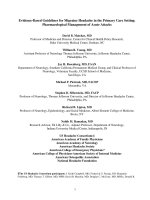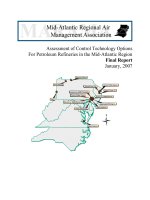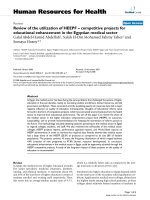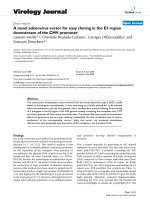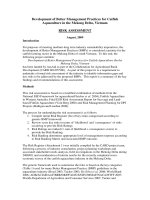Assessment of Control Technology Options For Petroleum Refineries in the Mid-Atlantic Region Final Report potx
Bạn đang xem bản rút gọn của tài liệu. Xem và tải ngay bản đầy đủ của tài liệu tại đây (2.35 MB, 206 trang )
Assessment of Control Technology Options
For Petroleum Refineries in the Mid-Atlantic Region
Final Report
January, 2007
About MARAMA
The Mid-Atlantic Regional Air Management Association is an association of ten state and local
air pollution control agencies. MARAMA's mission is to strengthen the skills and capabilities of
member agencies and to help them work together to prevent and reduce air pollution impacts in
the Mid-Atlantic Region.
MARAMA provides cost-effective approaches to regional collaboration by pooling resources to
develop and analyze data, share ideas, and train staff to implement common requirements.
The following State and Local governments are MARAMA members: Delaware, the District of
Columbia, Maryland, New Jersey, North Carolina, Pennsylvania, Virginia, West Virginia,
Philadelphia, and Allegheny County, Pennsylvania.
About MACTEC Federal Programs, Inc.
MACTEC, Inc. is a leader in the engineering, environmental and remedial construction
industries. MACTEC provides premier management, technical, and professional services to help
clients successfully manage complex businesses, projects, and facilities. Now operating with
over 100 U.S. offices and 4,000 employees with specialists in over 50 scientific and engineering
disciplines, MACTEC has the resources to perform virtually any scope of work, regardless of
location, size or complexity.
MACTEC Federal Programs, Inc. is a division of MACTEC that provides these same services
tailored to meet the unique needs of government agencies, including state/local agencies and
federal agencies.
For copies of this report contact:
MARAMA
Mid-Atlantic Regional Air Management Association
711 West 40th Street
Suite 312
Baltimore, MD 21211
phone 410.467.0170
fax 410.467.1737
/>
i
Assessment of Control Technology Options
For Petroleum Refineries
In the Mid-Atlantic Region
Final Technical Support Document
Prepared for:
Mid-Atlantic Regional Air Management Association (MARAMA)
Prepared by:
MACTEC Federal Programs, Inc.
560 Herndon Parkway, Suite 200, Herndon, VA 20170
January 31, 2007
______________________
______________________
Edward Sabo
Douglas A. Toothman
Principal Scientist
Principal Engineer
Assessment of Control Technology Options for Petroleum Refineries
January 31, 2007
Page i
ACKNOWLEDGEMENTS
MARAMA gratefully acknowledges the funding support provided by the United States
Environmental Protection Agency. This project was funded by grants from the U.S.
Environmental Protection Agency, Region II and Region III.
The following members of the Technical Oversight Committee (TOC) provided directions
guiding the project, reviewed the drafts of this report and gave insightful comments including:
Ravi Rangan, Delaware DNREC
Bruce Steltzer, Delaware DNREC
Max Friedman, New Jersey DEP
Ray Papalski, New Jersey DEP
Gopal Sistla, New York DEC
Thomas Barsley, Philadelphia AMS
Thomas Huynh, Philadelphia AMS
Henry Kim, Philadelphia AMS
Keith Lemchak, Philadelphia AMS
Tom Weir, Philadelphia AMS
Edward Wiener, Philadelphia AMS
David Brown, Pennsylvania DEP
Wick Havens, Pennsylvania DEP
George Monacky, Pennsylvania DEP
Sachin Shankar, Pennsylvania DEP
Brian Trowbridge, Pennsylvania DEP
Virendra Triveti, Pennsylvania DEP
Yogesh Doshi, Virginia DEQ
Fred Durham, West Virginia DEP
MARAMA’s project manager was Bill Gillespie, with oversight from Susan S.G. Wierman,
Executive Director of MARAMA.
MACTEC Federal Programs, Inc.
Assessment of Control Technology Options for Petroleum Refineries
January 31, 2007
Page ii
Table of Contents
EXECUTIVE SUMMARY .......................................................................................................... 1
1.0 EMISSION INVENTORY AND EXISTING REQUIREMENTS .................................. 1-1
1.1
EMISSION INVENTORY .......................................................................................................1-1
1.1.1 EMISSIONS BY REFINERY..............................................................................................1-2
1.1.2 EMISSIONS BY REFINERY PROCESS ...........................................................................1-5
1.1.3 COMPARISON OF MARAMA EMISSIONS TO OTHER STATES................................1-7
1.1.4 EMISSION UNCERTAINTIES ..........................................................................................1-8
1.2
EXISTING REQUIREMENTS ................................................................................................1-8
1.2.1 FEDERAL REGULATIONS...............................................................................................1-8
1.2.2 STATE/LOCAL REGULATIONS ......................................................................................1-9
1.2.3 PERMIT REQUIREMENTS .............................................................................................1-10
1.2.4 REQUIREMENTS FOR ENFORCEMENT SETTLEMENTS.........................................1-10
1.3
SELECTION OF SOURCE CATEGORIES FOR FURTHER EVALUATION ....................1-11
1.4
REFERENCES .......................................................................................................................1-12
2.0 CATALYTIC AND THERMAL CRACKING UNITS.................................................... 2-1
2.1
PROCESS DESCRIPTION ......................................................................................................2-1
2.2
EMISSION INVENTORY .......................................................................................................2-3
2.3
EXISTING REQUIREMENTS ................................................................................................2-5
2.3.1 FEDERAL REGULATIONS...............................................................................................2-5
2.3.2 STATE REGULATIONS ....................................................................................................2-6
2.3.3 PERMIT REQUIREMENTS ...............................................................................................2-6
2.3.4 REQUIREMENTS FROM RECENT ENFORCEMENT SETTLEMENTS.......................2-6
2.4
AVAILABLE CONTROL TECHNOLOGIES ......................................................................2-13
2.4.1 SO2 CONTROLS ...............................................................................................................2-13
2.4.1.1
Wet Scrubbing ...........................................................................................................2-13
2.4.1.2
DeSOx Additives.......................................................................................................2-16
2.4.1.3
Feed Hydrotreatment .................................................................................................2-16
2.4.2 NOX CONTROLS .............................................................................................................2-17
2.4.3 PM CONTROLS................................................................................................................2-19
2.4.3.1
Wet Scrubbing ...........................................................................................................2-19
2.4.3.2
Electrostatic Precipitators ..........................................................................................2-19
2.4.3.3
SBS Injection Technology.........................................................................................2-19
2.4.3.4
Third Stage Separators ..............................................................................................2-21
2.4.4 CO CONTROLS ................................................................................................................2-22
2.4.4.1
CO Boilers .................................................................................................................2-22
2.4.4.2
CO Combustion Promoters........................................................................................2-22
2.4.5 VOC CONTROLS .............................................................................................................2-23
MACTEC Federal Programs, Inc.
Assessment of Control Technology Options for Petroleum Refineries
2.5
2.6
January 31, 2007
Page iii
COSTS AND AVAILABILITY .............................................................................................2-23
REFERENCES .......................................................................................................................2-25
3.0 BOILERS AND PROCESS HEATERS ............................................................................ 3-1
3.1
PROCESS DESCRIPTION ......................................................................................................3-1
3.2
EMISSION INVENTORY .......................................................................................................3-1
3.3
EXISTING REQUIREMENTS ................................................................................................3-3
3.3.1 FEDERAL REQUIREMENTS ............................................................................................3-3
3.3.2 STATE REGULATIONS ....................................................................................................3-6
3.3.3 PERMIT REQUIREMENTS ...............................................................................................3-7
3.3.4 REQUIREMENTS FROM RECENT ENFORCEMENT SETTLEMENTS.......................3-7
3.4
AVAILABLE CONTROL TECHNOLOGIES ......................................................................3-11
3.4.1 SO2 CONTROLS...............................................................................................................3-11
3.4.1.1
Wet Scrubbers ...........................................................................................................3-11
3.4.1.2
Spray Dry Scrubbers..................................................................................................3-11
3.4.1.3
Dry Scrubbers............................................................................................................3-12
3.4.2 NOX CONTROLS .............................................................................................................3-12
3.4.2.1
Low NOx Burners .....................................................................................................3-12
3.4.2.2
Combustion Air Modifications..................................................................................3-15
3.4.2.3
SNCR.........................................................................................................................3-16
3.4.3 SELECTIVE CATALYTIC REDUCTION (SCR)............................................................3-17
3.4.4 PM CONTROLS................................................................................................................3-17
3.5
COSTS AND AVAILABILITY .............................................................................................3-17
3.6
REFERENCES .......................................................................................................................3-20
4.0 FLARES................................................................................................................................ 4-1
4.1
PROCESS DESCRIPTION ......................................................................................................4-1
4.2
EMISSION INVENTORY .......................................................................................................4-2
4.3
EXISTING REQUIREMENTS ................................................................................................4-6
4.3.1 FEDERAL REQUIREMENTS ............................................................................................4-6
4.3.2 STATE REGULATIONS ....................................................................................................4-7
4.3.3 REQUIREMENTS FROM RECENT ENFORCEMENT SETTLEMENTS.......................4-7
4.4
AVAILABLE CONTROL OPTIONS ......................................................................................4-8
4.4.1 FLARE GAS RECOVERY UNITS .....................................................................................4-9
4.4.2 CALIFORNIA REGULATIONS.......................................................................................4-10
4.4.2.1
BAAQMD .................................................................................................................4-10
4.4.2.2
SCAQMD ..................................................................................................................4-10
4.4.3 TEXAS REGULATIONS ..................................................................................................4-11
4.5
COSTS AND AVAILABILITY .............................................................................................4-12
4.5.1 FLARE GAS RECOVERY UNIT .....................................................................................4-12
4.5.2 COMPLIANCE WITH SCAQMD RULE 1118 ................................................................4-12
MACTEC Federal Programs, Inc.
Assessment of Control Technology Options for Petroleum Refineries
January 31, 2007
Page iv
4.5.3 COMPLIANCE WITH BAAQMD RULE 12 ...................................................................4-12
4.6
REFERENCES .......................................................................................................................4-17
5.0 FUGITIVE EQUIPMENT LEAKS.................................................................................... 5-1
5.1
PROCESS DESCRIPTION ......................................................................................................5-1
5.2
EMISSION INVENTORY .......................................................................................................5-1
5.3
EXISTING REQUIREMENTS ................................................................................................5-3
5.3.1 FEDERAL REGULATIONS...............................................................................................5-3
5.3.2 STATE REGULATIONS ....................................................................................................5-4
5.3.3 PERMIT REQUIREMENTS ...............................................................................................5-4
5.3.4 REQUIREMENTS FROM RECENT ENFORCEMENT SETTLEMENTS.......................5-5
5.4
AVAILABLE CONTROL TECHNOLOGIES ........................................................................5-5
5.4.1 ENHANCED LDAR ............................................................................................................5-5
5.4.2 SMART LDAR ....................................................................................................................5-7
5.5
COSTS AND AVAILABILITY ...............................................................................................5-8
5.6
REFERENCES .......................................................................................................................5-11
6.0 WASTEWATER TREATMENT ....................................................................................... 6-1
6.1
PROCESS DESCRIPTION ......................................................................................................6-1
6.2
EMISSION INVENTORY .......................................................................................................6-3
6.3
EXISTING REQUIREMENTS ................................................................................................6-5
6.3.1 FEDERAL REQUIREMENTS ............................................................................................6-5
6.3.2 STATE REGULATIONS ....................................................................................................6-6
6.3.3 REQUIREMENTS FROM RECENT ENFORCEMENT SETTLEMENTS.......................6-6
6.4
AVAILABLE CONTROL TECHNOLOGIES ......................................................................6-10
6.4.1 EQUIPMENT COVERS ....................................................................................................6-11
6.4.1.1
Water Seals on Drains and Junction Box Vents ........................................................6-11
6.4.1.2
Sealing Manholes ......................................................................................................6-12
6.4.1.3
Enclosing Weirs and Hard Piping .............................................................................6-13
6.4.1.4
Installing Domed Roofs on Sludge Tanks.................................................................6-13
6.4.2 POLLUTION CONTROL EQUIPMENT .........................................................................6-13
6.4.2.1
Air & Steam Stripping...............................................................................................6-13
6.4.2.2
Carbon Adsorption ....................................................................................................6-14
6.4.2.3
Combustion Devices..................................................................................................6-15
6.4.3 REDUCE VOCS FROM WASTEWATER .......................................................................6-15
6.4.4 SECONDARY TREATMENT CONTROL OPTIONS.....................................................6-16
6.5
COSTS AND AVAILABILITY .............................................................................................6-17
6.6
REFERENCES .......................................................................................................................6-19
7.0 STORAGE TANKS ............................................................................................................. 7-1
7.1
PROCESS DESCRIPTION ......................................................................................................7-1
MACTEC Federal Programs, Inc.
Assessment of Control Technology Options for Petroleum Refineries
January 31, 2007
Page v
7.1.1 FIXED ROOF TANKS ........................................................................................................7-1
7.1.2 EXTERNAL FLOATING ROOF TANKS..........................................................................7-2
7.1.3 INTERNAL FLOATING ROOF TANKS ...........................................................................7-4
7.1.4 DOMED EXTERNAL FLOATING ROOF TANKS ..........................................................7-5
7.1.5 VARIABLE VAPOR SPACE TANKS ...............................................................................7-6
7.1.6 PRESSURE TANKS............................................................................................................7-6
7.2
EMISSION INVENTORY .......................................................................................................7-6
7.3
EXISTING REQUIREMENTS ................................................................................................7-8
7.3.1 FEDERAL REQUIREMENTS ............................................................................................7-8
7.3.2 STATE REGULATIONS ..................................................................................................7-10
7.3.3 REQUIREMENTS FROM RECENT ENFORCEMENT SETTLEMENTS.....................7-10
7.4
AVAILABLE CONTROL TECHNOLOGIES ......................................................................7-33
7.4.1 CONTROLS FOR FIXED ROOF TANKS .......................................................................7-33
7.4.1.1
Install an Internal Floating Roof and Seals ...............................................................7-33
7.4.1.2
Vapor Balancing........................................................................................................7-33
7.4.1 FLOATING ROOF TANKS..............................................................................................7-33
7.4.1.3
Weather Shields.........................................................................................................7-34
7.4.1.4
Secondary Seals.........................................................................................................7-34
7.4.2 VAPOR RECOVERY SYSTEMS.....................................................................................7-34
7.4.2.1
Condensation .............................................................................................................7-34
7.4.2.2
Carbon Adsorption ....................................................................................................7-34
7.4.2.3
Absorption .................................................................................................................7-35
7.4.2.4
Incinerators ................................................................................................................7-35
7.4.3 MORE STRINGENT STANDARDS ................................................................................7-35
7.4.3.1
Vapor Pressure Criteria .............................................................................................7-36
7.4.3.2
Tank Cleaning ...........................................................................................................7-36
7.4.3.3
Maintenance Programs ..............................................................................................7-37
7.5
COSTS AND AVAILABILITY .............................................................................................7-37
7.6
REFERENCES .......................................................................................................................7-37
8.0 SULFUR RECOVERY UNITS .......................................................................................... 8-1
8.1
PROCESS DESCRIPTION ......................................................................................................8-1
8.2
EMISSION INVENTORY .......................................................................................................8-1
8.3
EXISTING REQUIREMENTS ................................................................................................8-1
8.3.1 FEDERAL REQUIREMENTS ............................................................................................8-1
8.3.2 STATE REGULATIONS ....................................................................................................8-1
8.3.3 REQUIREMENTS FROM RECENT ENFORCEMENT SETTLEMENTS.......................8-5
8.4
AVAILABLE CONTROL TECHNOLOGIES ........................................................................8-6
8.4.1 INCREASE CLAUS UNIT CAPACITY.............................................................................8-6
8.4.1.1
Oxygen Enrichment.....................................................................................................8-6
8.4.1.2
Selectox Catalyst .........................................................................................................8-7
MACTEC Federal Programs, Inc.
Assessment of Control Technology Options for Petroleum Refineries
January 31, 2007
Page vi
8.4.1.3
SUPERCLAUS® ........................................................................................................8-7
8.4.2 TAIL GAS TREATMENT...................................................................................................8-7
8.4.2.1
SCOT Tailgas Unit ......................................................................................................8-7
8.4.2.2
Sulfreen .......................................................................................................................8-8
8.4.2.3
Beaven Process............................................................................................................8-8
8.4.2.4
Stretford Process..........................................................................................................8-9
8.4.2.5
Clauspol.......................................................................................................................8-9
8.4.2.6
PROClaus ....................................................................................................................8-9
8.4.2.7
LO-CAT® ..................................................................................................................8-10
8.4.2.8
FLEXSORB® .............................................................................................................8-12
8.4.2.9
Emission Free Claus Unit ..........................................................................................8-12
8.4.2.10 Tail Gas Scrubbers & Incinerators ............................................................................8-12
8.5
COSTS AND AVAILABILITY .............................................................................................8-13
8.6
REFERENCES .......................................................................................................................8-16
APPENDIX A - METHODOLOGY FOR ESTIMATING EMISSION REDUCTIONS
FROM MODEL RULES
MACTEC Federal Programs, Inc.
Assessment of Control Technology Options for Petroleum Refineries
January 31, 2007
Page vii
List of Tables
Table ES-1
Key Findings
Table 1-1
Table 1-2
Table 1-3
Capacity and Emissions by Refinery for 2002
Capacity and Emissions by Refinery for 2009 (Accounting for Growth and
Effects of On-the-Books and On-the-Way Requirements)
Recent Enforcement Settlements Under EPA’s Petroleum Refinery Initiative
Table 2-1
Table 2-2
Table 2-3
Table 2-4
Table 2-5
Table 2-6
Emission Inventory for FCCUs and FCUs
Summary of MARAMA State Regulations for FCCUs/FCUs
Summary of Other State Regulations for FCCUs/FCUs
Summary of Permit Requirements for FCCUs/FCUs
Summary of Recent Enforcement Settlements for FCCUs/FCUs
Control Technology Options for FCCUs and FCUs
Table 3-1
Table 3-2
Table 3-3
Table 3-4
Table 3-5
Table 3-6
Emission Inventory for Boilers/Heaters
Summary of NSPS Regulations for Boilers & Process Heaters
Summary of MARAMA State Regulations
Summary of Other State Regulations
Summary of Recent Enforcement Settlements
Control Technology Options for Boilers and Process Heaters
Table 4-1
Table 4-2
Table 4-3
Table 4-4
Table 4-5
Emission Inventory for Flares
Summary of Recent Enforcement Settlements
Estimated Costs for Compliance with BAAQMD Rule 12
Estimated Costs for Compliance with SCAQMD Rule 1118
Control Technology Options for Flares
Table 5-1
Table 5-2
Emission Inventory for Equipment Leaks
Control Technology Options for Fugitive Equipment Leaks
Table 6-1
Table 6-2
Table 6-3
Table 6-4
Emission Inventory for Wastewater Treatment
Summary of MARAMA State Regulations
Summary of Other State Regulations
Control Technology Options for Wastewater Treatment
MACTEC Federal Programs, Inc.
Assessment of Control Technology Options for Petroleum Refineries
January 31, 2007
Page viii
List of Tables (continued)
Table 7-1
Table 7-2
Table 7-3
Table 7-4
Table 7-5
Emission Inventory for Storage Tanks
Properties of Group 1 Storage Vessels
Summary of MARAMA State Regulations
Summary of Other State Regulations
Control Technology Options for Storage Tanks
Table 8-1
Table 8-2
Table 8-3
Table 8-4
Table 8-5
Emission Inventory for Sulfur Recovery Units
Summary of MARAMA State Regulations
Summary of Other State Regulations
Summary of Recent Enforcement Settlements
Control Technology Options for Sulfur Recovery Units
List of Figures
Figure ES-1
Figure ES-2
Figure ES-3
Figure ES-4
Figure ES-5
Figure ES-6
Figure ES-7
Figure ES-8
Figure 1-1
Figure 1-2a
Figure 1-2b
Figure 1-2c
Figure 1-2d
Figure 1-3
Emission Reductions from Consent Decrees and Model Rules - SO2 Emissions
from Fluidized Catalytic Cracking Units
Emission Reductions from Consent Decrees and Model Rules - NOx Emissions
from Fluidized Catalytic Cracking Units
Emission Reductions from Consent Decrees and Model Rules - PM Emissions
from Fluidized Catalytic Cracking Units
Emission Reductions from Consent Decrees and Model Rules - CO Emissions
from Fluidized Catalytic Cracking Units
Emission Reductions from Consent Decrees and Model Rules - VOC Emissions
from Equipment Leaks
Emission Reductions from Consent Decrees and Model Rules - SO2 Emissions
from Flares
Emission Reductions from Consent Decrees and Model Rules - NOx Emissions
from Flares
Emission Reductions from Consent Decrees and Model Rules - VOC Emissions
from Flares
Location of Petroleum Refineries in the Mid-Atlantic States
NOx Emissions by Process
PM2.5 Emissions by Process
SO2 Emissions by Process
VOC Emissions by Process
Comparison of 2002 MARAMA Refinery Capacity and Emissions with Other
States
MACTEC Federal Programs, Inc.
Assessment of Control Technology Options for Petroleum Refineries
List of Figures (continued)
Figure 2-1
Figure 2-2
Figure 2-3
Figure 2-4
Figure 2-5
Figure 2-6
Diagram of a Fluidized Catalytic Cracking Unit
EDV-Wet Scrubbing System
Diagrams of HEV and JEV Scrubbers
BOC Gase’s LoTOx Process
SBS Injection Technology Process Diagram
Typical TSS and FSS Arrangement
Figure 4-1
Figure 4-2
Diagram of a Typical Steam-Assisted Elevated Flare
Process Flow Diagram of a Flare Gas Recovery Unit
Figure 6-1
Figure 6-2
Figure 6-3
Figure 6-4
Typical Refinery Wastewater Collection and Treatment System
Liquid Seal Insert for Process Drain
Diagram of Refinery Manhole
Diagram of the Air Stripping Improvement
Figure 7-1
Figure 7-2
Figure 7-3
Figure 7-4
Figure 7-5
Vertical Fixed Roof Tank
Pontoon External Floating Roof Tank
Double-Deck External Floating Roof Tank
Internal Floating Roof Tank
Domed External Floating Roof Tank
Figure 8-1
Figure 8-2
Figure 8-3a
Figure 8-3-b
Figure 8-4
Typical Claus Sulfur Recovery Unit Process Flow Diagram
Diagram of a 3-Stage PROClaus Process
Direct LO-CAT Tail Gas System
Indirect LO-CAT Tail Gas System
Lurgi Emission Free Sulfur Recovery Unit
MACTEC Federal Programs, Inc.
January 31, 2007
Page ix
Assessment of Control Technology Options for Petroleum Refineries
January 31, 2007
Page x
Acronyms and Abbreviations
Acronym
ACT
BACT
BART
CO
CTG
EPA
ESP
FCCU
FCU
FGD
HAP
LAER
LDAR
MACT
MANE-VU
MARAMA
NESHAP
NH3
NOx
NSPS
NSR
PM10-PRI
Description
Alternative Control Technique
Best Available Control Technology
Best Available Retrofit Technology
Carbon Monoxide
Control Technique Guideline
U.S. Environmental Protection Agency
Electrostatic Precipitator
Fluid Catalytic Cracking Unit
Fluid Coking Unit
Flue Gas Desulfurization
Hazardous Air Pollutant
Lowest Achievable Emission Rate
Leak Detection and Repair
Maximum Achievable Control Technology
Mid-Atlantic/Northeast Visibility Union
Mid-Atlantic Regional Air Management Association
National Emission Standard for Hazardous Air Pollutants
Ammonia
Oxides of nitrogen
New Source Performance Standard
New Source Review
Particulate matter less than or equal to 10 microns in diameter that includes both the
filterable and condensable components of particulate matter
PM25-PRI
Particulate matter less than or equal to 2.5 microns in diameter that includes both
the filterable and condensable components of particulate matter
PSD
RACT
SCR
SIP
SNCR
SO2
SRU
VOC
WGS
WWTP
Prevention of Significant Deterioration
Reasonably Available Control Technology
Selective Catalytic Reduction
State Implementation Plan
Selective non-Catalytic Reduction
Sulfur dioxide
Sulfur Recovery Unit
Volatile organic compounds
Wet Gas Scrubber
Wastewater Treatment Plant
MACTEC Federal Programs, Inc.
Assessment of Control Technology Options for Petroleum Refineries
Executive Summary
January 31, 2007
Page ES-1
EXECUTIVE SUMMARY
This report was prepared for the Mid-Atlantic Regional Air Management Association
(MARAMA) as part of an effort to assist states in developing State Implementation Plans (SIPs)
for ozone, fine particles, and regional haze. MARAMA’s members requested assistance in
assessing control measure options for petroleum refinery emissions and in developing model rule
provisions. The project was completed in three phases:
•
Phase I analyzed emissions from all refinery processes, identified existing pollution
control requirements, and assessed refinery processes in order of significance of
emissions and the potential for additional emission reductions. Section 1 of this report
presents the results of Phase I.
•
Phase II identified potential control measures for seven refinery processes and evaluated
the cost and technical feasibility of controls. Sections 2-8 contain the analyses of control
measure options for the seven refinery processes selected for evaluation.
•
Phase III involved the drafting of model rules for states to consider as they develop their
SIPs. At the direction of the MARAMA board, model rules were developed for three
processes: catalytic cracking units, equipment leaks, and flares.
This Executive Summary presents the key findings of the assessments.
This Technical Support Document (TSD) is intended to assist States in developing rules or other
implementation mechanisms, as necessary and appropriate, as part of their control strategy
analysis process for attaining the 8-hour ozone and fine particulate National Ambient Air Quality
Standards (NAAQS) and regional haze goals. The TSD does not attempt to define Reasonably
Available Control Technology (RACT) or any other particular control level for the refinery
processes it examines. With many jurisdictions in the Mid-Atlantic Region facing the need to
achieve additional emission reductions, MARAMA was asked by member States to analyze all
refinery processes and determine where additional emission reductions were achievable. The
TSD does not attempt to define RACT, best available control technology (BACT), lowest
achievable emission rate (LAER), or best available retrofit technology (BART). MARAMA
member States recognize that the determination of these control levels requires the consideration
of site-specific factors. These considerations will be address in individual State and local
rulemaking and permitting processes.
Evaluation of Available Control Options
MACTEC, in consultation with the MARAMA Refinery Technical Oversight Committee (TOC),
reviewed the emission inventory and the existing requirements for each of the sources found at
petroleum refineries. Based on that review, the TOC selected the following refinery processes
for further evaluation of candidate control measures: 1) catalytic and thermal cracking units, 2)
MACTEC Federal Programs, Inc.
Assessment of Control Technology Options for Petroleum Refineries
Executive Summary
January 31, 2007
Page ES-2
boilers and process heaters, 3) flares, 4) equipment leaks, 5) wastewater treatment, 6) storage
tanks, and 7) sulfur recovery plants. These categories were chosen because they account for a
large portion of the emission inventory and there is a potential for obtaining additional emission
reductions. This study evaluated emissions, existing requirements, and available control
technology options and typical costs. Table ES-1 presents the key findings regarding the
emission inventory, existing requirements, and available control options.
Development of Model Rules
After reviewing the draft TSD, MARAMA’s TOC instructed MACTEC to prepare three draft
model rules for fluid catalytic cracking units, enhanced equipment leak detection and repair, and
flares. While the recent consent decrees provide important air quality benefits, the MARAMA
TOC decided to develop model rules to (a) to codify and perpetuate the requirements of the
consent decrees, and (b) provide more stringent requirements where technologically feasible and
cost-effective options have been identified. The model rule for the fluid catalytic cracking units
is generally based on the requirements of the recent consent decrees, with a more stringent limit
for carbon monoxide emissions. The model rule for enhanced LDAR is generally based on the
requirements of the recent consent decrees, but with a lower leak definition for valves. The
model rule for flares is primarily based on the requirements of the South Coast Air Quality
Management District’s recently amended flare rule, which includes more stringent requirements
for flare gas recovery systems, flare minimization procedures, and flare monitoring.
Potential Impact of Model Rules
The assessment found that significant emission reductions will be achieved as a result of
requirements already in place in recent Consent Decrees for 10 of the 14 petroleum refineries in
the MARAMA region. Adoption of the model rules would achieve additional emission
reductions at refineries where consent decrees have not been negotiated. These reductions would
be modest, however, since the refineries in question are relatively small capacity facilities. Two
refineries without Consent Decrees are in northwest Pennsylvania, and because of their location,
modest reductions from these facilities may have little impact on the nonattainment areas.
Significant reductions in emissions from fluidized catalytic cracking units (FCCUs) will result
from the implementation of the Consent Decrees. Some additional reductions in emissions from
FCCUs may be possible, as a few refineries currently are only required to meet the NSPS limit of
1 lb/1000 lbs coke. The model rule limit of 0.5 lbs/ 1000 lbs coke would reduce PM emissions
for these refineries by 50 percent. The model rule also reduces the CO limit for the FCCUs.
Figures ES-1 to ES-4 show the anticipated emission reductions from FCCUs at refineries in the
MARAMA region. Appendix A documents how the emission reductions were calculated.
MACTEC Federal Programs, Inc.
Assessment of Control Technology Options for Petroleum Refineries
Executive Summary
January 31, 2007
Page ES-3
Implementation of the Consent Decrees enhanced leak detection will reduce VOC emissions
significantly. Implementation of the model rule will reduce emissions modestly beyond the
levels established by the recently negotiated consent decrees. Figure ES-5 shows the anticipated
emission reductions from equipment leaks at refineries in the MARAMA region.
Implementation of the model rules for flares would reduce refinery emissions beyond the levels
established by the recently negotiated consent decrees to some extent. Figures ES-6, ES-7, and
ES-8 show the anticipated emission reductions from flares at refineries in the MARAMA region.
The flare rule will require better monitoring of flaring emissions, the development and
implementation of flare monitoring and control of flare emissions. Recent studies at west coast
refineries and in Texas have shown that flare emissions are larger than originally thought and
likely larger than estimates contained in the current State emission inventories. As a result of the
possible underestimation of emissions in the inventories, controlling flares may achieve more
sizable emission reductions in the “real world” than are currently estimated based on the
emission inventory.
MACTEC Federal Programs, Inc.
Assessment of Control Technology Options for Petroleum Refineries
Executive Summary
January 31, 2007
Page ES-4
Table ES-1 Key Findings
Refinery Process
Emission Inventory
Existing Requirements
Available Control Options
Fluid Catalytic
Cracking Units
(FCCUs)
and
Fluid Coking
Units (FCUs)
There are 12 FCCUs and one FCU
in the MARAMA region. These 13
emission units accounted for about
78% of the SO2 and 29% of the
NOx emitted from all refinery
processes in 2002. As a result of
the existing requirements in
Consent Decrees, SO2 emissions
are expected to be reduced by 90%
and NOx emissions by 38% by
2009.
Eight these FCCUs and the single
FCU are required to control SO2
and NOx emissions as a result of
Consent Decrees which contain
more stringent requirements that
existing federal rules, State/local
rules, or permit requirements. Four
other FCCUs are not affected by the
Consent Decrees.
SO2:
1) Wet gas scrubber (or other technology) capable
of meeting 25 ppmvd @ 0% O2 based on 365-day
rolling average or 50 ppmvd @ 0% O2 based on 7day rolling average. Cost Effectiveness: $5003,000/ton
2) DeSOx additives capable of meeting 300 ppmvd.
Cost Effectiveness*: $500-880/ton
NOx:
SCR or SNCR system (or other technology)
capable of meeting 20 ppmvd, measured as a 365day rolling average, and 40 ppmvd, measured as a
7-day rolling average, @ 0% O2.
NOx Cost Effectiveness*: $1520-2458/ton
Boilers
and
Process
Heaters
Emissions from these units
represent the largest category of
NOx emission sources at refineries
and the second largest source of
SO2 emissions. Boilers and process
heaters accounted for 63% of the
NOx and 15% of the SO2 emitted
from all refinery processes in 2002.
As a result of the existing
requirements in Consent Decrees,
SO2 emissions are expected to be
reduced by 32% and NOx
emissions by 36% by 2009.
10 of the 14 refineries are required
to control SO2 and NOx emissions
as a result of Consent Decrees that
contain more stringent requirements
that existing federal rules,
State/local rules, or permit
requirements. The Consent Decrees
will generally require the
elimination of fuel oil burning in
boilers/heaters, compliance with
NSPS Subpart J refinery gas H2S
limits, and installation of qualifying
controls to reduce NOx emissions.
SO2:
1) Eliminate or limit liquid fuel firing
2) Limit sulfur content of liquid fuels;
3) Limit hydrogen sulfide content of refinery fuels
to NSPS limit of 0.10 gr/dscf (162 ppm)
SO2 Cost Effectiveness*: not quantified
NOx:
1) San Joaquin Rule 4306 limits of 0.0062 to 0.036
lb/MMBtu for gaseous fuels and 0.052 lb/MMBtu
for liquid fuels; Cost Effectiveness: to be
determined.
2) SNCR, SCR, Ultra-low NOx burners (or other
technology) capable of meeting 0.04 lb/MMBtu;
Cost Effectiveness*: $750-7402 per ton, depending
on size of unit and fuel type
MACTEC Federal Programs, Inc.
Assessment of Control Technology Options for Petroleum Refineries
Executive Summary
January 31, 2007
Page ES-5
Refinery Process
Emission Inventory
Existing Requirements
Available Control Options
Flares
Flares account for about 7% of the
NOx, 4% of the SO2, and 10% of
the VOC emitted at the 14 refineries
in 2002. Actual emissions are
uncertain due to inadequate
monitoring of flare gas flow rates
and composition. Evidence from
California and Texas suggests that
emissions from flaring activities
(and other nonroutine releases) may
be significantly underreported in
current emission inventories.
Requirements contained in the
Consent Decrees are generally more
stringent than existing state/local
rules and permit requirements. The
Consent Decrees require
compliance with NSPS emission
limits and actions to prevent upsets
that result in flaring.
SO2, VOC, NOx, PM:
Establish and follow flare minimization plan;
Install analyzers to measure vent gas flow, higher
heating value, and VOC/sulfur concentration;
Conduct emissions reviews and root cause
analyses, and take corrective actions after
significant flaring events;
Install flare gas recovery and treatment systems.
Cost Effectiveness*: $4527-7063 per ton (total
SO2, NOx, VOC, and PM reduced).
Equipment Leaks
(Fugitive
Emissions)
Leaking equipment components
account for 15% of the VOC
emitted at the 14 refineries in 2002.
Actual emissions are uncertain due
to difficulty in accurately
monitoring thousands of individual
components.
The Consent Decrees contain
requirements for “enhanced” leak
detection and repair programs to
reduce fugitive emissions;
otherwise subject to NSPS or
NESHAP requirements
VOC:
“Enhanced” leak detection and repair program
requirements based on program elements contained
in the Consent Decrees. Elements include: written
LDAR procedures; training of assigned personnel;
internal and third party audits; more stringent leak
definitions; increased monitoring frequency;
corrective action for “chronic leakers”; electronic
storing and reporting of data; additional QA/QC
requirements.
Cost Effectiveness*: $1300/ton
Wastewater
Treatment
Wastewater treatment accounts for
21% of the VOC emitted at the 14
refineries in 2002
Many systems already subject to
NSPS Subpart QQQ, NESHAP
Subpart CC, or NESHAP Subpart
FF requirements; Consent Decrees
require review and verification of
compliance status and corrective
actions to correct noncompliance.
VOC:
For wastewater collection systems, installing
covers and seals on the collection components to
reduce fugitive VOC emissions,
For wastewater treatment system, maintaining or
installing a control device such as carbon canisters
to destroy VOCs released during treatment
VOC Cost Effectiveness*: $1900-4200/ton
MACTEC Federal Programs, Inc.
Assessment of Control Technology Options for Petroleum Refineries
Executive Summary
January 31, 2007
Page ES-6
Refinery Process
Emission Inventory
Existing Requirements
Storage Tanks
Storage tanks account for 26% of
Most tanks already subject to either
the VOC emitted at the 14 refineries NSPS, NESHAP, or state
in 2002
requirements
Sulfur Recovery
Units
Sulfur recovery plants accounted
for 2% of the SO2 emitted at the 14
refineries in 2002; over half of all
SO2 emissions from sulfur recovery
unit come from the Giant
Yorktown, VA, SRU.
The Consent Decrees generally
require compliance with NSPS
Subpart J and the elimination,
control, and monitoring of sulfur pit
emissions. The Giant Yorktown
refinery is required to install a tail
gas unit or equivalent control
technology. The ConocoPhillips
Bayway refinery is to conduct an
optimization study and implement
recommendations.
Available Control Options
VOC:
Install floating roofs in fixed roof tanks; install
domed fixed roof on external floating roof tank;
replace vapor-mounted primary seal with a liquidmounted primary seal; install secondary seals; use
vapor recovery systems or incineration.
VOC Cost Effectiveness*: not quantified
SO2:
A variety of control technologies are available
which can meet the NSPS emission limit of 250
ppmv, dry basis, corrected to zero percent oxygen
SO2 Cost Effectiveness*: $167-449/ton
* See Sections 2-8 for a discussion of the references used to determine the cost-effectiveness for each source category. The cost data provided in this table were
obtained from the published literature as referenced. In general, the percent reductions and cost data represent data for typical sources that are uncontrolled.
Site-specific factors can affect the actual cost effectiveness. Incremental costs for sources that already have some level of control will likely be higher.
MACTEC Federal Programs, Inc.
Assessment of Control Technology Options for Petroleum Refineries
Executive Summary
January 31, 2007
Page ES-7
Figure ES-1 Emission Reductions from Consent Decrees and Model Rules
SO2 Emissions from Fluidized Catalytic Cracking Units
Cracking Units SO2 Em issions
50,000
45,000
Giant Yorktown
40,000
United Refining
Sunoco Phila. PB 868
SO2 (tpy)
35,000
Sunoco Phila. GP 1232
ConocoPhillips Trainer
30,000
Sunoco Marcus Hook
25,000
ConocoPhillips/Bayway
20,000
Amerada Hess
Valero
15,000
Sunoco Eagle Point
10,000
Premcor FCU
Premcor FCCU
5,000
0
2002
2009 with CDs
2009 W ith Model Rules
20,000
17,500
15,000
12,500
10,000
7,500
5,000
2,500
0
2002
2009 with CDs
H
es
s
/B
on
ay
M
oc
ar
w
cu
ay
oP
Su
s
hi
H
no
ll i
p s oo
co
Tr k
Ph
Su
i la a in
no
co . G e r
Ph P 1
23
i la
2
U
ni . P
B
te
86
d
R
G
ef 8
ia
in
nt
i
Y o ng
rk
to
w
n
co
C
Su
no
hi
ll i
ps
a
ad
C
on
oc
oP
A
m
er
gl
Ea
co
no
Su
MACTEC Federal Programs, Inc.
ro
le
in
Va
e
Po
C
rF
C
C
co
rF
em
co
Pr
em
Pr
t
U
2009 W ith Model Rules
U
SO2 Tons/year
Cracking Unit SO2 Emissions
Assessment of Control Technology Options for Petroleum Refineries
Executive Summary
January 31, 2007
Page ES-8
Figure ES-2 Emission Reductions from Consent Decrees and Model Rules
NOx Emissions from Fluidized Catalytic Cracking Units
Cracking Units NOx Em issions
6,000
Giant Yorktown
5,000
United Refining
Sunoco Phila. PB 868
Sunoco Phila. GP 1232
NOx (tpy)
4,000
ConocoPhillips Trainer
Sunoco Marcus Hook
3,000
ConocoPhillips/Bayway
Amerada Hess
2,000
Valero
Sunoco Eagle Point
Premcor FCU
1,000
Premcor FCCU
0
2009 with CDs
2002
2009 with CDs
MACTEC Federal Programs, Inc.
m
le
e
co
ro
P h ra d
a
Su
il l
He
ip
no
ss
co s/ B
C
ay
on
M
w
ar
oc
ay
oP c u
Su
s
hi
H
no
ll
oo
c o i ps
k
Tr
Ph
Su
ai
i la
no
ne
.G
co
r
Ph P 1
23
il
2
U a. P
ni
te B 8
d
R 68
G
e
ia
n t fin i
Y o ng
rk
to
w
n
Va
A
on
o
C
Su
no
co
Ea
gl
e
Po
C
rF
C
co
rF
em
co
in
t
U
2009 W ith Model Rules
Pr
em
Pr
2009 W ith Model Rules
Cracking Unit NOx Emissions
1,600
1,400
1,200
1,000
800
600
400
200
0
CU
NOx (tpy)
2002
Assessment of Control Technology Options for Petroleum Refineries
Executive Summary
January 31, 2007
Page ES-9
Figure ES-3 Emission Reductions from Consent Decrees and Model Rules
PM Emissions from Fluidized Catalytic Cracking Units
Cracking Units PM Emissions
3,000
Giant Yorktown
2,500
United Refining
Sunoco Phila. PB 868
Sunoco Phila. GP 1232
PM10 (tpy)
2,000
ConocoPhillips Trainer
Sunoco Marcus Hook
1,500
ConocoPhillips/Bayway
Amerada Hess
1,000
Valero
Sunoco Eagle Point
Premcor FCU
500
Premcor FCCU
0
2002
2009 w/ CDs
2009 w/ Model Rules
This table shows reductions of total suspended particulate emissions; reductions in PM2.5 are not available.
Cracking Unit PM Emissions
800
2002
PM10 (tpy)
600
2009 w/ CDs
2009 w/ Model Rules
400
200
Pr
em
co
rF
Su Pr
em C C
no
co co U
E a r FC
gl
U
e
Po
in
C
on
t
A
Va
m
oc
er
le
oP
ad
ro
Su hi
a
He
n o l li p
s
ss
c
C
on o M / Ba
yw
oc
ar
S u oP c u s a y
n o h il
H
c o li ps o o
k
P
Su
T
n o hi la r ain
.G
er
co
Ph P
12
il
U a. P 32
ni
te B 8
d
G
R 68
ia
e
n t fin
Y o i ng
rk
to
w
n
0
MACTEC Federal Programs, Inc.
Assessment of Control Technology Options for Petroleum Refineries
Executive Summary
January 31, 2007
Page ES-10
Figure ES-4 Emission Reductions from Consent Decrees and Model Rules
CO Emissions from Fluidized Catalytic Cracking Units
Cracking Units CO Emissions
6,000
Giant Yorktown
5,000
United Refining
Sunoco Phila. PB 868
Sunoco Phila. GP 1232
PM10 (tpy)
4,000
ConocoPhillips Trainer
Sunoco Marcus Hook
3,000
ConocoPhillips/Bayway
Amerada Hess
2,000
Valero
Sunoco Eagle Point
Premcor FCU
1,000
Premcor FCCU
0
2002
2009 with CDs
2009 W ith Model Rules
1,800
1,500
1,200
900
600
300
0
2002
2009 with CDs
m
A
on
o
C
MACTEC Federal Programs, Inc.
co
er
l
a d e ro
P
Su hi
a
H
n o l li p
co s/ B ess
C
on
a
M
ar yw
oc
cu
ay
S u oP
s
n o h il
H
c o li ps o o
k
P
Su
T
n o hi la r ain
.G
er
co
Ph P
12
il
U a. P 32
ni
te B 8
d
R 68
G
e
ia
n t fin
Y o i ng
rk
to
w
n
Va
C
Po
Ea
co
Su
no
gl
e
rF
C
co
rF
em
co
Pr
em
Pr
in
t
U
2009 W ith Model Rules
CU
PM10 (tpy)
Cracking Unit CO Emissions
Assessment of Control Technology Options for Petroleum Refineries
Executive Summary
January 31, 2007
Page ES-11
Figure ES-5 Emission Reductions from Consent Decrees and Model Rules
VOC Emissions from Equipment Leaks
Equipm ent Leak VOC Em issions
1,600
Ergon Newell
Giant Yorktown
1,400
United Refining
VOC (tpy)
1,200
Sunoco Philadelphia
American Refining
1,000
ConocoPhillips Trainer
Sunoco Marcus Hook
800
ConocoPhillips/Bayway
600
Chevron
400
CITGO Asphalt
Amerada Hess
Valero
200
Sunoco Eagle Point
Premcor
0
2002
2009 w/ CDs
2009 w/ Model Rules
Equipment Leak VOC Emissions
VOC (tpy)
400
300
2002
2009 w/ CDs
2009 w/ Model Rules
200
100
Su
no
co
P
E a re m
co
gl
e
Po r
in
C
IT
t
G V al
A O A e ro
m
C
er sp
on
ad ha
oc
l
a
oP
He t
Su h
C
h ss
n il
C o c li ps e v r
on o
o
/
o c M a Ba y n
oP rc w
a
u
A h il l s H y
m ip
S u er s o ok
n o ic a Tr a
c o n R in
P h ef er
U i la i ni n
ni d
te el g
G d R phi
ia
n t e fi a
Y ni
E r o rk ng
g o to
w
n
Ne n
w
el
l
0
MACTEC Federal Programs, Inc.
Assessment of Control Technology Options for Petroleum Refineries
Executive Summary
January 31, 2007
Page ES-12
Figure ES-6 Emission Reductions from Consent Decrees and Model Rules
SO2 Emissions from Flaring
Flaring SO2 Em issions
2,000
Ergon Newell
1,800
Giant Yorktown
United Refining
1,600
Sunoco Philadelphia
SO2 (tpy)
1,400
American Refining
ConocoPhillips Trainer
1,200
Sunoco Marcus Hook
1,000
ConocoPhillips/Bayway
800
Chevron
Amerada Hess
600
CITGO Asphalt
400
Valero
200
Sunoco Eagle Point
Premcor
0
2002
2009 with CDs
2009 W ith Model Rules
Flaring SO2 Emissions
1,200
SO2 (tpy)
1,000
2002
2009 with CDs
800
2009 W ith Model Rules
600
400
200
Su
no
co
gl
e
Ea
Pr
em
co
Po r
in
C
t
IT
G V al
O
er
A
m As o
C
er p
on
ad ha
oc
lt
a
He
o
Su Ph
s
C
he s
n il l
vr
C o c i ps
on o
o
/B
o c Ma a y n
oP rc wa
y
h u
A il li s H
m
ps o o
S u er
k
n o ic a Tr a
in
co n R
e
P h ef r
in
U i la
ni d i ng
te elp
G d R hi
ia
a
n t efin
Y o in
E r rk g
g o to
w
n
Ne n
w
el
l
0
MACTEC Federal Programs, Inc.

